As an avid anime fan, I’ve watched the medium grow and evolve over the years. I started reading anime many moons ago and, more recently, I have got into watching the cartoons too. From its humble beginnings as a niche subculture to its current status as a global phenomenon, anime has come a long way. In this article, I’ll explore the changes that anime has undergone over the years, and why it has become so popular.
The Early Days of Anime
Anime first emerged in Japan in the early 20th century, as a way to tell stories through animation. The medium was heavily influenced by traditional Japanese art, such as woodblock prints and manga (Japanese comics). At first, anime was produced primarily for a domestic audience, but it quickly gained popularity overseas, particularly in the United States.
In the 1960s and 70s, anime began to take on a more distinct style, with shows like “Astro Boy” and “Speed Racer” becoming international hits. These shows helped establish anime as a viable medium for storytelling, and paved the way for future anime creators to explore a wide range of genres and themes.
The Rise of the Otaku
As anime gained popularity, so did its fanbase. In the 1980s, a new subculture emerged in Japan known as “otaku.” Otaku refers to people who are obsessed with anime, manga, and other forms of Japanese pop culture. While the term initially had negative connotations, it has since been embraced by fans as a way to express their love for anime.
The otaku subculture had a significant impact on the anime industry. As demand for anime grew, so did the number of anime studios and creators. This led to an explosion of creativity in the medium, with anime creators experimenting with new genres, storytelling techniques, and art styles.
The Modern Era of Anime
Today, anime is more popular than ever before. It has become a global phenomenon, with fans from all over the world flocking to conventions, buying merchandise, and discussing their favorite shows online. In recent years, anime has also gained mainstream recognition, with shows like “Attack on Titan” and “Demon Slayer” becoming cultural phenomena.
One reason for anime’s continued popularity is its ability to appeal to a wide range of audiences. Anime covers a vast array of genres, from action and adventure to romance and comedy. This diversity means that there’s something for everyone in the world of anime, whether you’re a casual viewer or a die-hard fan.
Another reason for anime’s success is its ability to tell complex and thought-provoking stories. Anime has tackled a wide range of themes and issues, from the consequences of war and social inequality to the meaning of love and friendship. The medium’s ability to address these issues in a nuanced and mature way has helped it gain a reputation as a serious art form.
The Future of Anime
As anime continues to evolve, it’s hard to predict what the future holds for the medium. However, one thing is clear: anime is here to stay. With its global popularity and vast creative potential, anime has become a cultural force that will continue to shape popular culture for years to come.
As the medium continues to grow and expand, we can expect to see more experimentation with new genres and art styles, as well as more stories that explore complex themes and issues. And with the rise of streaming services like Netflix and Crunchyroll, anime has become more accessible than ever before, making it easier for fans around the world to discover new and exciting shows.
Anime has come a long way since its early days. Take that from someone who’s had a longstanding interest in it. There is no doubt that it is now a global phenomenon. In fact, anime has become a cultural force to be reckoned with. Its ability to tell complex and thought-provoking stories, combined with its diverse range of genres and styles, has made it a favorite among fans around the world. If you haven’t given it a try, now is the time!






